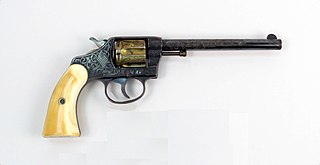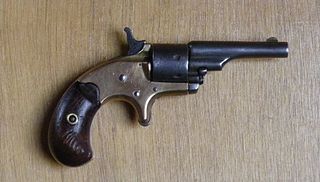
The Colt AR-15 is a lightweight, magazine-fed, gas-operated semi-automatic rifle. It is a semi-automatic version of the M16 rifle sold for the civilian and law enforcement markets in the United States. The AR in AR-15 stands for ArmaLite rifle, after the company that developed it in the 1950s. Colt's Manufacturing Company currently owns the AR-15 trademark, which is used exclusively for its line of semi-automatic AR-15 rifles.
A repeating rifle is a single-barreled rifle capable of repeated discharges between each ammunition reload. This is typically achieved by having multiple cartridges stored in a magazine and then fed individually into the chamber by a reciprocating bolt, via either a manual or automatic action mechanism, while the act of chambering the round typically also recocks the hammer/striker for the following shot. In common usage, the term "repeating rifle" most often refers specifically to manual repeating rifles, as opposed to self-loading rifles, which use the recoil and/or blowback of the previous shot to cycle the action and load the next round, even though all self-loading firearms are technically a subcategory of repeating firearms.
Pump action or slide action is a repeating firearm action that is operated manually by moving a sliding handguard on the gun's forestock. When shooting, the sliding forend is pulled rearward to eject any expended cartridge and typically to cock the hammer/striker, and then pushed forward to load (chamber) a new cartridge into the chamber. Most pump-action firearms use an integral tubular magazine, although some do use detachable box magazines. Pump-action firearms are typically associated with shotguns, although it has been used in rifles, grenade launchers, as well as other types of firearms.

.22 BB Cap, also known as the 6mm Flobert, is a variety of .22 caliber rimfire ammunition. Invented by Louis-Nicolas Flobert in 1845, it was the first rimfire metallic cartridge. The .22 BB Cap and .22 CB Cap are interchangeable and are relatively quiet low velocity cartridges, designed for indoor target shooting.
The Winchester Repeating Arms Company was a prominent American manufacturer of repeating firearms and ammunition. The firm was established in 1866 by Oliver Winchester and was located in New Haven, Connecticut. The firm went into receivership in 1931 and was bought by the Western Cartridge Company, a forerunner of the Olin Corporation. The Winchester brand name is still owned by the Olin Corporation, which makes ammunition under that name. The Winchester name is also used under license for firearms produced by two subsidiaries of the Herstal Group – FN Herstal of Belgium and the Browning Arms Company of Ogden, Utah.
Christian Sharps was the inventor of the Sharps rifle, the first commercially successful breech-loading rifle and the Sharps Four Barrel Pistol, and Sharps Breech-Loading Pistol.

Sharps rifles are a series of large-bore, single-shot, falling-block, breech-loading rifles, beginning with a design by Christian Sharps in 1848 and ceasing production in 1881. They were renowned for long-range accuracy. By 1874, the rifle was available in a variety of calibers, and it was one of the few designs to be successfully adapted to metallic cartridge use. The Sharps rifles became icons of the American Old West with their appearances in many Western-genre films and books. Perhaps as a result, several rifle companies offer reproductions of the Sharps rifle.

The Sharps-Borchardt Model 1878 is a single-shot hammerless falling-block action rifle designed by Hugo Borchardt and made by the Sharps Rifle Manufacturing Company. It closely resembles older Sharps Rifles but has a firing mechanism that uses a hammerless striker rather than a hammer and firing pin like the old Sharps Rifle. This hammerless dropping-block breech-loader was based on a patent granted to Hugo Borchardt in 1877. It was the last of the Sharps single-shot rifles, and the Borchardt did not sell very well. According to company records 8,700 rifles were made in all models from 1878 until the Sharps Rifle Co. closed down in 1881. Although it was designed for the huge black powder "buffalo" cartridges of the day, it came too late, at the very end of the great bison slaughter.

An antique firearm is a term used to describe a firearm that was designed and manufactured prior to the beginning of the 20th century. Although the exact definition of what constitutes an "antique firearm" varies between countries, the advent of smokeless powder or the start of the Boer War are often used as cut-off dates. Antique firearms are usually collected because of their historical interest and/or their monetary value.

The Volcanic Repeating Arms Company was an American company formed in 1855 by partners Horace Smith and Daniel B. Wesson to develop Walter Hunt's Rocket Ball ammunition and lever action mechanism. Volcanic made an improved version of the Rocket Ball ammunition, and a carbine and pistol version of the lever action gun to fire it. While the Volcanic Repeating Arms Company was short-lived, its descendants, Winchester Repeating Arms Company and Smith & Wesson became major firearms manufactures.
The Sharps & Hankins Model 1862 Carbine was a sliding breech action carbine made by Sharps & Hankins Co. in the 1860s and designed by Christian Sharps. The gun is a rimfire .52 caliber and was made in Philadelphia in a quantity of about 8,000. This firearm, patented on July 9, 1861 by Christian Sharps. The Navy version had a 24 inch barrel with a leather cover to protect the barrel from salt water. The Army version's barrel was blued. The Short Cavalry version had a 19 inch blued barrel.
A-Square Company, LLC was a manufacturer of rifles, ammunition and bullets based in Chamberlain, South Dakota in the United States. The company was one of 19 that are members of the Sporting Arms and Ammunition Manufacturer's Institution (SAAMI). The company's focus was on its firearms for hunting large dangerous game. This was reflected in the selection of larger caliber chamberings in the company's rifles.

The Colt Lightning Carbine or Colt Lightning Rifle was a slide-action (pump-action) rifle manufactured by Colt from 1884 until 1904 and was originally chambered in .44-40 caliber. Colt eventually made the Lightning Rifle in three different frame sizes, to accommodate a wide range of cartridges, from .22 Short caliber and .38-40 to .50-95 Express. Its profile resembles the pump-action rimfire rifles made by the Winchester Repeating Arms Company and Remington Arms. The Lightning saw use as a sporting arm in America and was adopted for use by the San Francisco Police Department, but was never as popular or as reliable as the various lever-action rifles of its day.

The Colt New Police is a double-action, six-shot revolver. This gun was chambered in the .32 New Police, which is dimensionally identical to a flat-nose version of the .32 S&W Long, except for the nose shape. In addition to the .32 New Police cartridge, the revolver was available in 32 Colt. The diameters of the two cartridges are not the same, with the 32 Colt being approximately 0.020 inches smaller in diameter than the New Police. Although the 32 Colt can be loaded and fired in the New Police chamber, it is not recommended to do so. It is impossible to load the .32 New Police in a 32 Colt chamber. The later .32 New Police chambering was more popular than the 32 Colt chambering.

Rollin White was an American gunsmith who invented a single shot bored-through revolver cylinder that allowed paper cartridges to be loaded from the rear of a revolver's cylinder. Because the open breeches were unprotected from lateral fire, all charges would instantly explode in a chain fire. Only one gun would be built to White's specifications, and that for use in a trial to show the impracticality of the gun. The gun could not fire metallic cartridges.
A gallery gun, Flobert gun, parlor gun or saloon gun is a type of firearm designed for recreational indoor target shooting. These guns were developed in 1845, when French inventor Louis-Nicolas Flobert created the first rimfire metallic cartridge by modifying a percussion cap to hold a small lead bullet. In the 19th century, gallery guns were typically pump-action rifles chambered in .22 Short. Gallery guns are still manufactured, although by the late 20th century, they have been eclipsed by airguns for the purpose of indoor shooting.

The Colt New Line was a single action pocket revolver introduced by the Colt's Patent Fire Arms Manufacturing Company in 1873.

The Colt Open Top Pocket Model Revolver was a single action pocket revolver introduced by the Colt's Patent Fire Arms Manufacturing Company in 1871. Introduced a year before the Colt Open Top and two years before the Colt Peacemaker and the Colt New Line, the Colt Open Top Pocket Model Revolver was, alongside the Colt House Revolver, one of the two first metallic cartridge rear-loading revolvers manufactured by Colt's. It also was one of the first pocket metallic cartridge revolvers made by the company.

The Colt-Burgess rifle, also known as the 1883 Burgess rifle or simply the Burgess rifle, is a lever-action repeating rifle produced by Colt's Patent Firearms Manufacturing Company between 1883 and 1885. The Burgess rifle was Colt's only entrance into the lever-action rifle market, produced to compete with Winchester Repeating Arms Company's line of popular rifles. The 1883 Burgess rifle was designed and patented by Andrew Burgess, an American firearms designer and photographer, who sold the design to Colt.

A repeating firearm or repeater is any firearm that is capable of being fired repeatedly before having to manually reloaded with new ammunition into the weapon.
7.Marcot, Roy - Marron, Edward - Paxton, Ron. "Sharps Firearms: The Percussion Era 1848 - 1865"
















